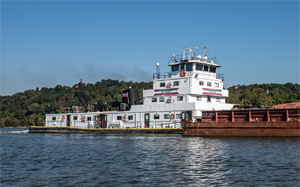As summer came to a close and high water finally receded on the Mississippi and Ohio rivers, the fleets at Cairo, Ill., and Paducah, Ky., were busy making up tows following nearly nine months of disruptions.
Capt. Daniel Morgan, at the helm of the 145-foot Jeffboat, maneuvered a 20-barge tow to American Commercial Barge Lines’ East Cairo fleet at mile marker 978, three miles upstream from the Ohio River’s confluence with the Mississippi.
The lead hand on the forward watch, Levi Harris, and deck hand David Jowers broke up the tow as Morgan turned over the helm to David Sylvaria, in training for his pilot’s license. Sylvaria steered the towboat to the ACBL dock for supplies.
Just before noon, the pilot, Capt. Tom More, and the mate, Jessie “Pineapple” Ziemer, appeared on the bridge to take the after watch. The mate on a brownwater vessel, equivalent to a bosun on a bluewater boat, oversees the deck crew. “No one on the river knows me by Jessie,” said Ziemer, who hails from Hawaii.
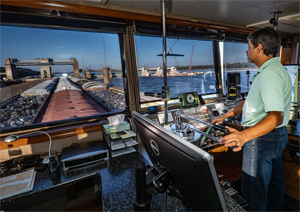 |
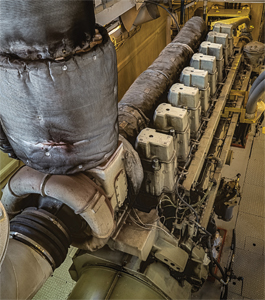 |
|
|
Capt. Daniel Morgan guides the 145-foot Jeffboat and its 15-barge tow into the new Olmsted Locks on the Ohio River. “When the water is up, it can get exciting,” he says. |
Two GE 8125OMDA9 main engines linked to Lufkin gears generate 6,200 horsepower at 1,050 rpm. |
Wilma Pickett, the cook from Benton, Ky., was in the galley assembling thick slices of corned beef and cheese on rye bread for a lunch that would not be out of place in a high-end deli. “I love the life,” she said. “I’ve been around boats and the river all of my life.”
Jeffboat was built at Jeffboat in Jeffersonville, Ind., in 1981. Once the nation’s largest inland shipbuilder, the company closed in 2018. The towboat is powered by two GE 8125OMDA9 main engines with Lufkin RHS 3624 gears, generating 6,200 horsepower at 1,050 rpm.
After lunch, More maneuvered Jeffboat to the stern of a tow of 15 jumbo barges loaded with scrap metal, steel, aluminum, salt and billets destined for Cincinnati. Ziemer, with deck hands James “Cass” Lynch and Demika Ferguson, faced up and deployed the head gear at the bow of the tow in preparation for transiting the Olmsted Locks and Dam in Illinois. Olmsted had reopened for locking in August once the Ohio River returned to its normal flow.
At 1335, More backed the tow into the channel and headed upriver. After more than 30 years on inland waterways, the captain is retired but takes three or four tours a year for a break. “The Ohio is not a particularly difficult river to navigate, except at high and extremely low water,” he said.
With plenty of high water to negotiate last year, making the locks and bridges was challenging. “In high-water conditions the current at the locks sets you from one side to the other, and the bends are in such a severe radius that the only way around them is to flank around them,” More said.
On the other hand, during low-water conditions, there is always a chance of running aground. “In normal conditions, other than making the locks and bridges, this is a relatively simple river to run,” he said. “There is virtually no flanking unless you are in high-water conditions.”
On the approach to Olmsted at mile marker 964.4, More pulled back on the throttles, slowing the tow from 5.5 mph to 3 mph, and eased up to the upper mooring cell downriver from the locks. The deck crew tied off the tow to wait for the northbound Jacie E. and the southbound Danny Etheridge to lock through.
While waiting, Morgan ascended the stairs to the pilothouse to take the forward watch, a climb he has made many times since starting with ACBL as a deck hand in 1998.
With Jacie E. in the riverside chamber and Danny Etheridge locked through and swinging its tow back into the channel, Morgan eased Jeffboat’s tow ahead, in line with the guide wall on the riverside lock.
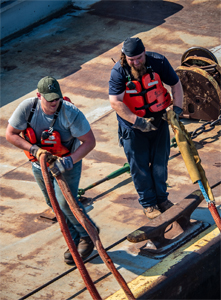 |
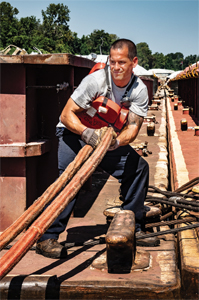 |
|
|
Levi Harris, lead hand on the forward watch, breaks up a tow with deck hand David Jowers at the ACBL fleeting area in East Cairo, Ill. |
Deck hand James “Cass” Lynch faces up the tow prior to Jeffboat’s transit to the Olmsted Locks and Dam. |
As he closed on the long wall, the shadow boat Bailey Matthew moved to the head of the tow to be ready to assist. The U.S. Army Corps of Engineers is keeping shadow boats at Olmsted until construction of the dam is finished, and the crane barges and equipment dismantling the obsolete Locks 52 and 53 are gone.
The $3 billion Olmsted facility became operational in August 2018 after three decades of cost overruns, delays and grumbling. The dam created the Olmsted Pool, 47 miles downriver from the Smithland Lock and Dam.
After Jacie E. locked through, Morgan eased the tow into the riverside chamber. Ziemer called out the distance to the upriver gates and the width to the lock wall. “He’s very good,” Morgan said. “I never have to ask him for information.” At 1745, the tow was locked in and tied off.
After the upper gates were opened, Morgan eased the tow out of the chamber and entered the Olmsted Pool. Jeffboat then pushed past the derrick barges demolishing the remains of Lock 53 and headed for Smithland Lock and Dam.
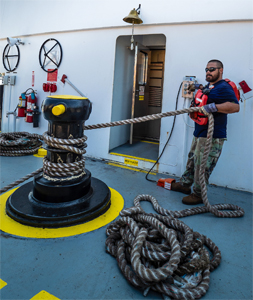 |
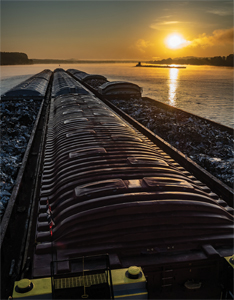 |
|
|
Jeffboat mate Jessie “Pineapple” Ziemer employs the capstan to tighten a line on the tow. |
Its navigation of the Olmsted Locks complete, Jeffboat pushes its tow toward the rising sun over the Olmsted Pool. |
Jeffboat is a utility boat in the ACBL fleet, a go-anywhere vessel not confined to any particular river. Therefore Morgan, at the helm on all of the inland rivers open to commercial navigation, was only on his third trip through the new locks at Olmsted. “When the water is up, it can get exciting,” he said. “This was a good experience with the newer technology.”
A design element introduced at Olmsted is a shallow funnel-shaped approach to the chamber wall. “The funnel gives a little more room to get in,” Morgan said. “The new Olmsted gives easy access. I’m glad to see it operational because the old 52 and 53 were so tough to get into. And the dam will maintain the pool to Smithland during low-water conditions.”
Shortly before midnight, More arrived in the pilothouse to take the after watch and guide the tow through the early morning hours, locking at Smithland at 0330. First light pierced the fog spreading over the Smithland Pool as Morgan took the forward watch and continued up the Ohio River.
Morgan and More in turn took the helm past the Wabash River, Evansville, Tell City, Leavenworth, Louisville, Madison and Markland. They dropped the tow at the McGinnis fleet at mile marker 473 in Covington, Ky., across the river from Cincinnati. The crew set about building a new tow, faced up, and headed southbound for Cairo.

